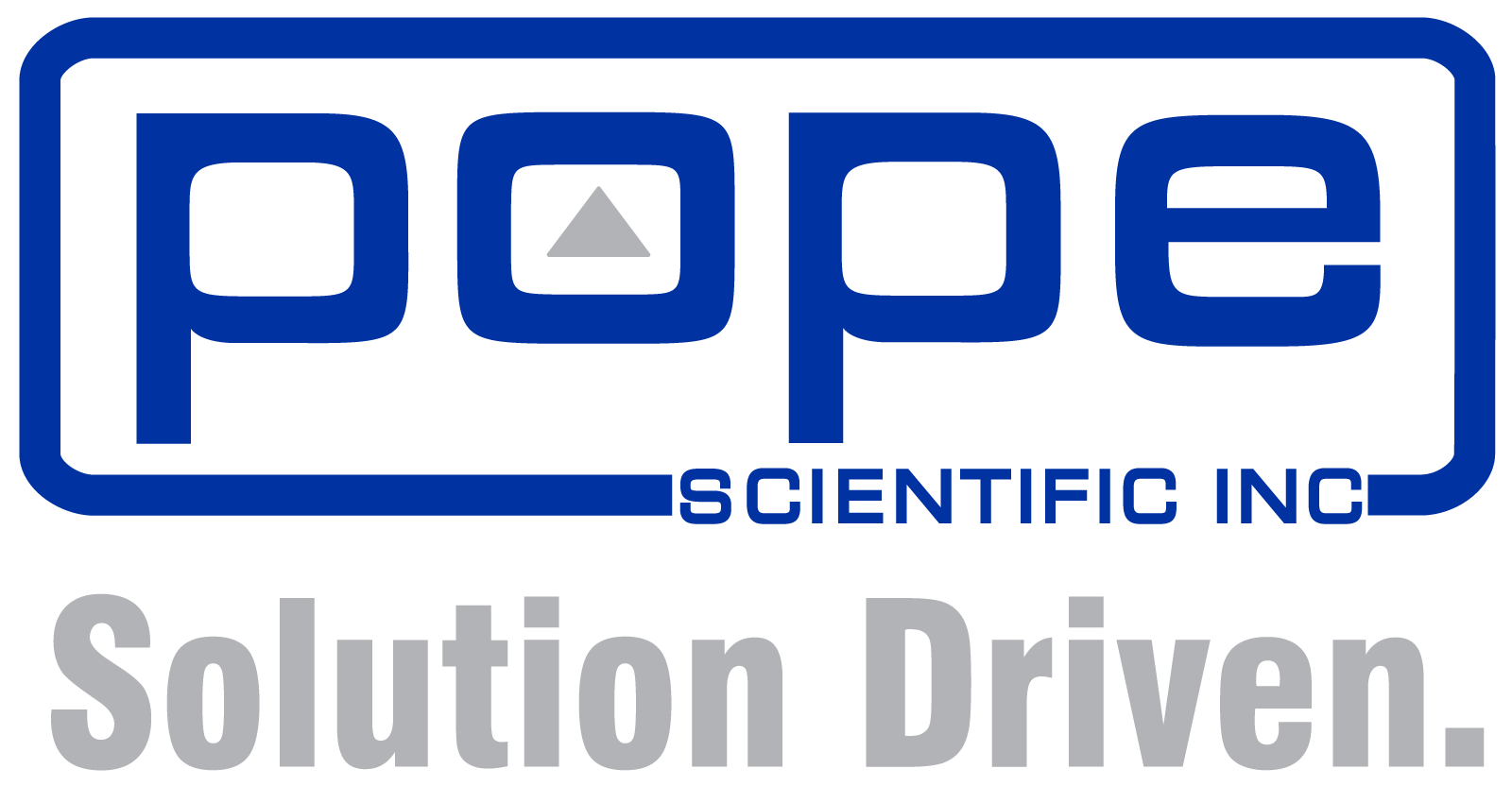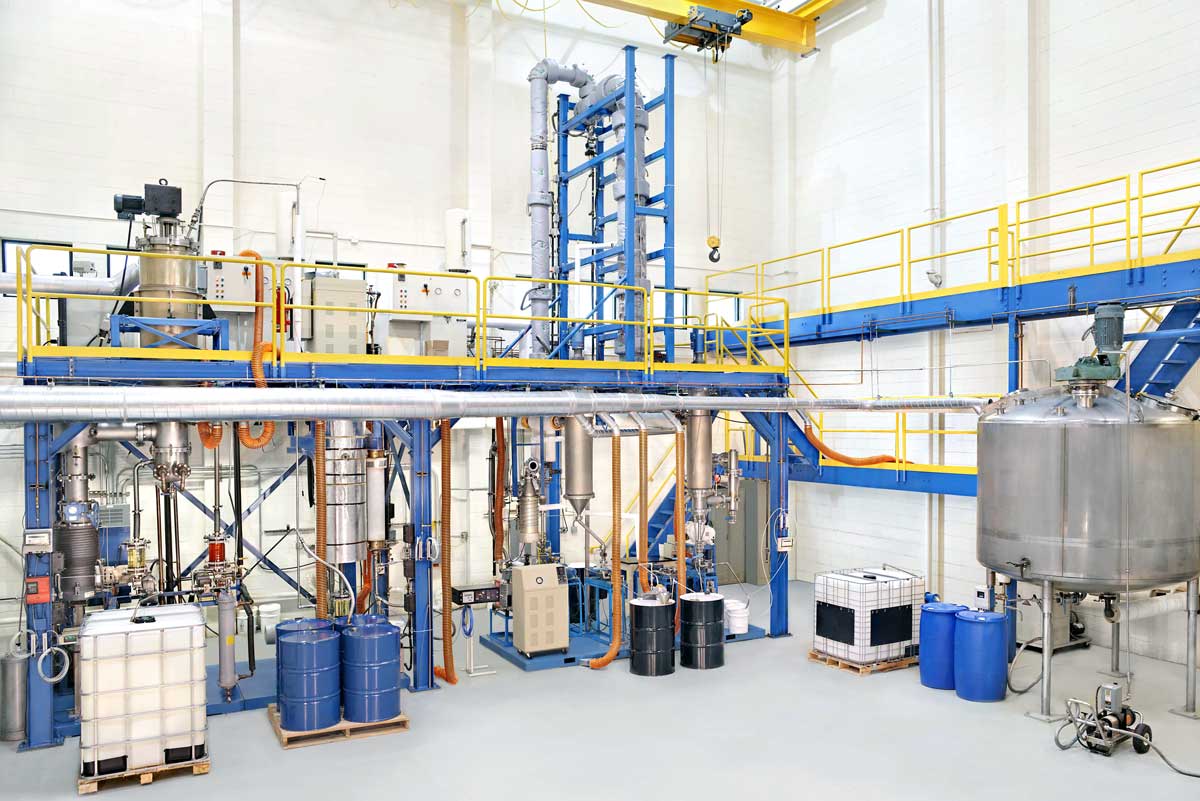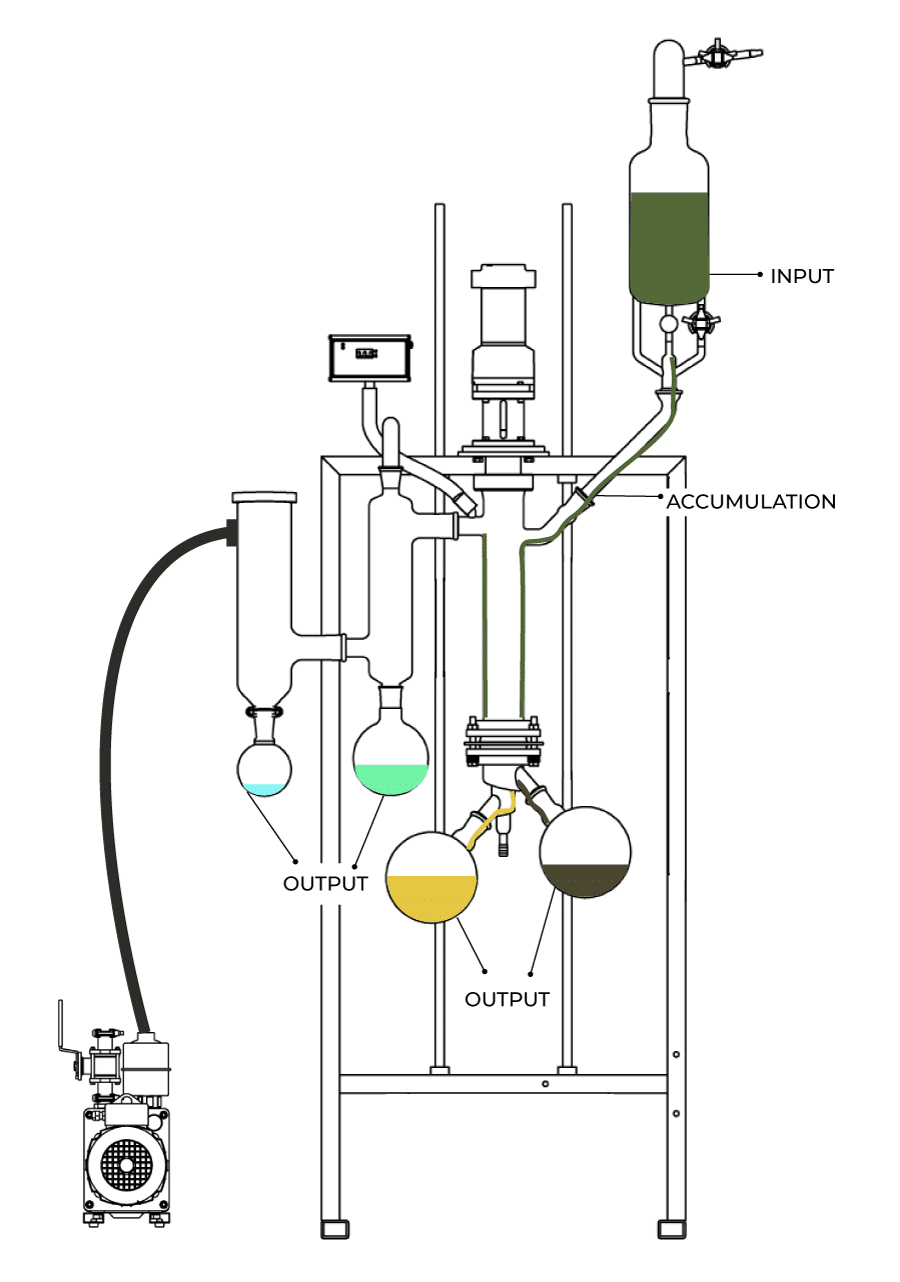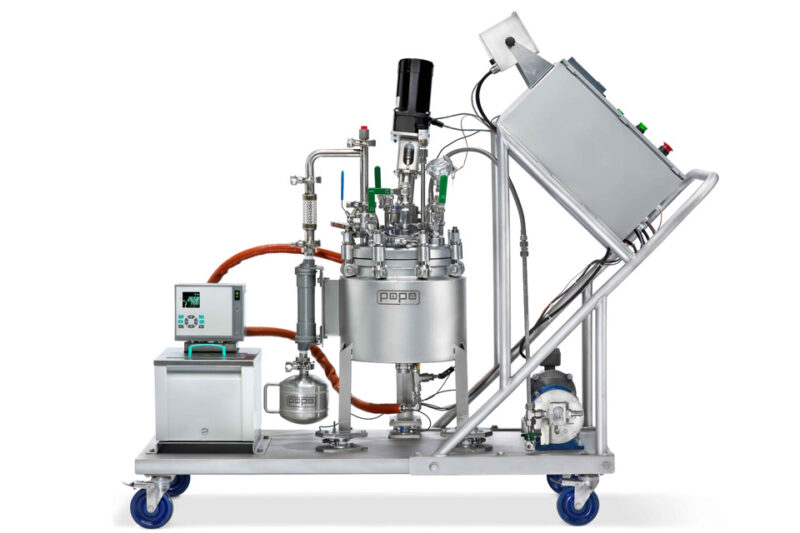Determining Which Fractional Distillation Process to Use: Batch or Continuous Mode
Introduction
Distillation is an important method for the separation and purification of liquids in a wide range of industries and laboratories. For optimal purification in distillation, a vertical column is incorporated into the equipment with either a series of internal stacked plates (trays) or else filled with one of various types of structured or dumped-in packing. The purpose of the trays or packing is to provide a high degree of vapor-liquid contact which results in multiple equilibrium stages or “theoretical plates”, each one leading to increasing purification all the way up the column, with the purest and lowest boiling point (BP) vaporized component(s) escaping the top of the column to contact a condenser where it leaves the column as a liquid distillate. The overall result is that specific components of the starting composition have been separated, or fractionated, giving this process the name, fractional distillation. Fractional stills often operate under pressure or vacuum and have a reflux device section for controlling and optimizing purity vs. throughput rate, however, these and several other topics of distillation equipment are not covered here. In this article, we will take a look at the two different types of fractional distillation; batch mode and continuous mode.
Batch Distillation Mode

Continuous Fractional Distillation Systems
Batch mode is the normal starting point of any distillation process and is the “simpler” of the modes. Here, a fixed amount of feed material, (a batch) is loaded into a boiling vessel (pot), onto which is mounted a column with a condenser at the top. The pot is heated and after a certain amount of time, the liquid begins to boil, and portions of it vaporize and travel up the column. (One well-known example of batch mode is the traditional making of “moonshine” where a fermented mixture is loaded into the pot, heated, and an ethanol-enriched distillate is collected). The first feed components to vaporize are ones with lower boiling points (BP) than the others. These components move up the column, with the lowest BP component in the feed becoming increasingly purified by means of fractionation finally being condensed and leaving the rest of the mixture as described above, to be collected in a distillate receiver. This will continue until the first component of lower BP is depleted in the boiling pot.
At this point, if the process is allowed to continue, the next component of BP greater than the first begins to make the travel all the way up to the condenser to be condensed, leaving as another distillate fraction that can be collected in a different receiver than the first. Some feed materials may contain many components and this means of separating several of them, one after the other, in order of increasing BP, can be continued until the desired product components have been collected at which point, the distillation process is ended by shutting off the heating of the boiling pot.
Examples of batch stills are many and can include anything from isolation of a flavor component in an extracted natural botanical source to recovering certain solvents from a waste mixture for reuse. A key characteristic of batch mode is that the composition of the feed material in the pot is constantly, incrementally changing throughout the duration of the run. The composition in the pot at the moment will be different an hour from now or even just a few minutes from now. The distillate collected will also change in composition over time as each subsequent component is distilled away. Thus, this is not a steady-state process.
In situations where the quantity of starting feed material becomes quite large, for example well beyond 1000 liters, and feed lots must be processed frequently, for example, at least every day, batch mode will become quite limited in addressing production requirements. Another method for fractional distillation is then needed and this is when continuous mode must be considered.
Continuous Distillation Mode 
Continuous mode fractional distillation can handle very large quantities of feed without the need for very large boiling vessels. Instead, feed is pumped at a set flow rate into the distillation system which has a column and condenser which can be similar to a batch-type setup. However, in this case, a reboiler replaces the boiling vessel and this is outfitted with apparatus for continuous discharge of residue, often referred to as a “bottoms stream”. The feed is preheated and enters the column at a height selected to optimize the overall process efficiency. Distillate leaves the system from the condenser, similar to the case of batch mode. So, in continuous mode, there is one stream entering the system and two streams exiting the system, the distillate, and the residue.
A key characteristic of continuous mode is that the compositions of these streams and at any point within the distillation equipment do not change over time as in batch mode, instead they remain constant, in a steady state throughout the entire run, the duration of which may go on for a considerable time. Oil refineries are a well-known example; these typically operate 24/7, being stopped only for maintenance or other technical reasons. There are exceptions to the 3-stream scheme described above; for example, in addition to the distillate collected at the top of the column, there may be multiple take-off points (side-streams) at various heights of the column. In the case of oil refinery columns, these will be multiple component cuts including gasoline, diesel, and mixed solvents in the upper column region, and oil cuts of increasing weight and viscosity as the locations get closer to the bottom of the column. It is important to note that these are never pure single-component cuts, but collections of many components of somewhat similar BP, for example, one stream may become further processed to become 10W-40 motor oil, and another stream may be used to create a variety of lighter lubricants, etc. The heaviest components of all become the materials used in tars, asphalts, and the like.
Other continuous fractional applications may involve feed streams with several, but far fewer individual components than are found in crude petroleum oil. Examples include many specialty chemicals such as pharmaceutical intermediates and electronics materials manufactured in reactors. The target product(s) may be somewhere in the middle of the range of the BP’s of several byproducts that must be removed. For high-purity products, side draws cannot be utilized, these will not be pure enough. To isolate pure components, more than a single column is needed, the number being dependent on the number of components in the feed. For example, the first column may be used to distill away several components which are lower in BP than the desired product. The residue can then serve as feed to a second column which will distill away the product plus a byproduct of BP near that of the product. This distillate stream may be fed to a third column which separates the product away from the byproduct that is co-distilled from the second column. This type of separation of pure components is more easily done with a single batch still if heat sensitivity is not a problem, (waiting for the product to start coming off the column and collecting it separately), however, as mentioned earlier, this is not practical with very large feed quantities; instead, a battery of staged continuous mode columns is called for.
There are many considerations that go into the design of a fractional column distillation system. These factors can vary depending on the scale at which you are manufacturing. When working at a commodity scale it often makes sense to manufacture in a continuous fashion, however, on the pilot and small production scale an important consideration is whether to use a batch approach. In addition to scale, there are a few other factors that play a considerable role such as the quantity of material, purity, energy use, and how many components need to be separated. These are highlighted in the figure below:
Energy Usage
Energy consumption in continuous distillation is lower than that of batch distillation. Heat recovery can be utilized, and the process loops optimized for both product quality and energy consumption. Energy usage can also be optimized by both preheating the feed material and selecting the best column entry point for the feed stream, reducing the condenser and reboiler duties. In batch mode, more energy is required in startup and because much of the heat is applied to evaporating the same material portions multiple times; this effect is reduced in continuous mode operation.

Pope Continuous Fractional Distillation System

Pope Batch Fractional Distillation System
Process Development and Scaleup; Lab, Pilot Plant, and Production Scale
As mentioned, in nearly all cases, batch mode is the starting point for fractional distillation. Even if the long-range goals call for very large production quantities and continuous mode installation will eventually be needed, new product development typically starts with lab scale and this will be batch mode. Lab scale equipment with boiling vessels of less than 1 liter up to 12 liters is appropriate for process feasibility studies. The lab-scale distillation experimentation may be part of an extensive general product development project. For example, it may be found that upstream chemistry and reactions need to be changed to allow proper distillation and other downstream operations work well, followed by more experimentation, etc. If lab studies are successful, it is normally advisable to move on to stainless steel (or other higher alloy if necessary) pilot scale equipment. This may include batch stills from a few liters in size up to 100 liters or more. It may also include pilot scale continuous stills with column diameters from 1” to 12” and feed rates from 1 to a few hundred liters/hr. Equipment of the larger end of these ranges can also serve as small or mid-size production systems as needed. Examples of such equipment are shown.
Pope Scientific offers batch fractional stills in glass from 1 to 22 liters and in stainless steel from 2 to 2000 liters or larger. Continuous fractional still systems are available in stainless steel with from 1” to 24” column diameters. All of the above equipment is normally designed and manufactured in skid-mounted modular turnkey form. Instrumentation can range from control elements only to fully integrated PLC control systems. Semi-turnkey systems and core distillation components alone are also available. During pilot plant studies, it may be found that the distillation system may need to be reconfigured somewhat in order to optimize the process. Pope takes this into account in the design of pilot plants, for example, allowing the ability to add or decrease column height or addition of collection receivers, etc. Control systems for continuous systems are more complex as there are several control loops required to achieve a steady state. However, the programs required for batch systems can be more extensive than for continuous, depending on what the user wants to accomplish. This is because there are usually several time and event-based changes in operating parameters during the run which may be automated, with routines set up by the operator before the run begins.
Pope maintains a staff highly knowledgeable in applications assistance, chemical engineering, chemistry, and chemical equipment operation, providing the customer with a partner for matching processing needs to equipment optimized for the lab, pilot, or production project. In addition to the provision of equipment, Pope can offer lab and pilot scale studies, depending on the nature of the specific applications. Experienced personnel in mechanical and electrical engineering, assembly, quality assurance, and documentation assure the equipment will work well from delivery and startup and will last for decades.





 case of post-extraction decarbing, one of the most efficient known methods is to have a batch of liquid extract contained within a stainless steel reaction vessel which is heated under vacuum conditions and rapidly stirred.
case of post-extraction decarbing, one of the most efficient known methods is to have a batch of liquid extract contained within a stainless steel reaction vessel which is heated under vacuum conditions and rapidly stirred.



